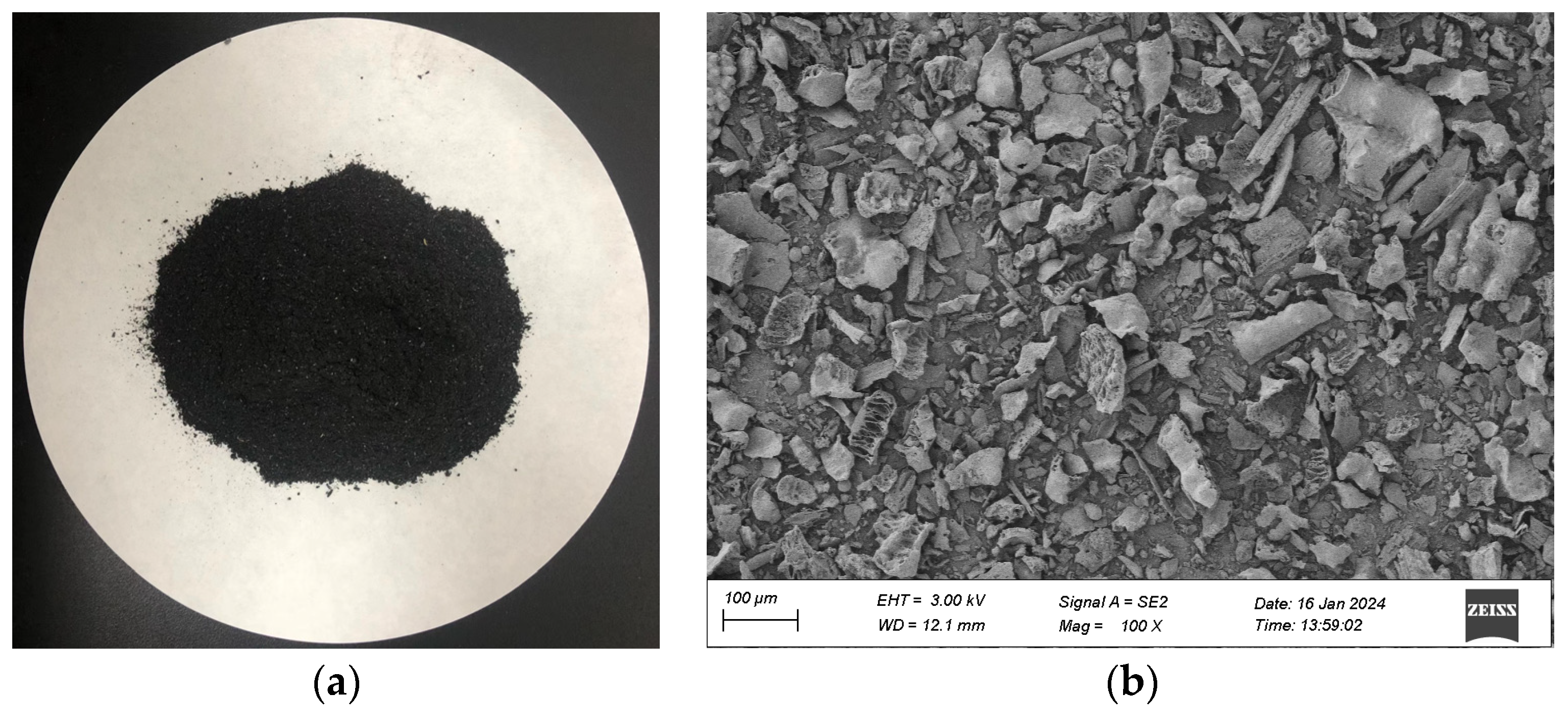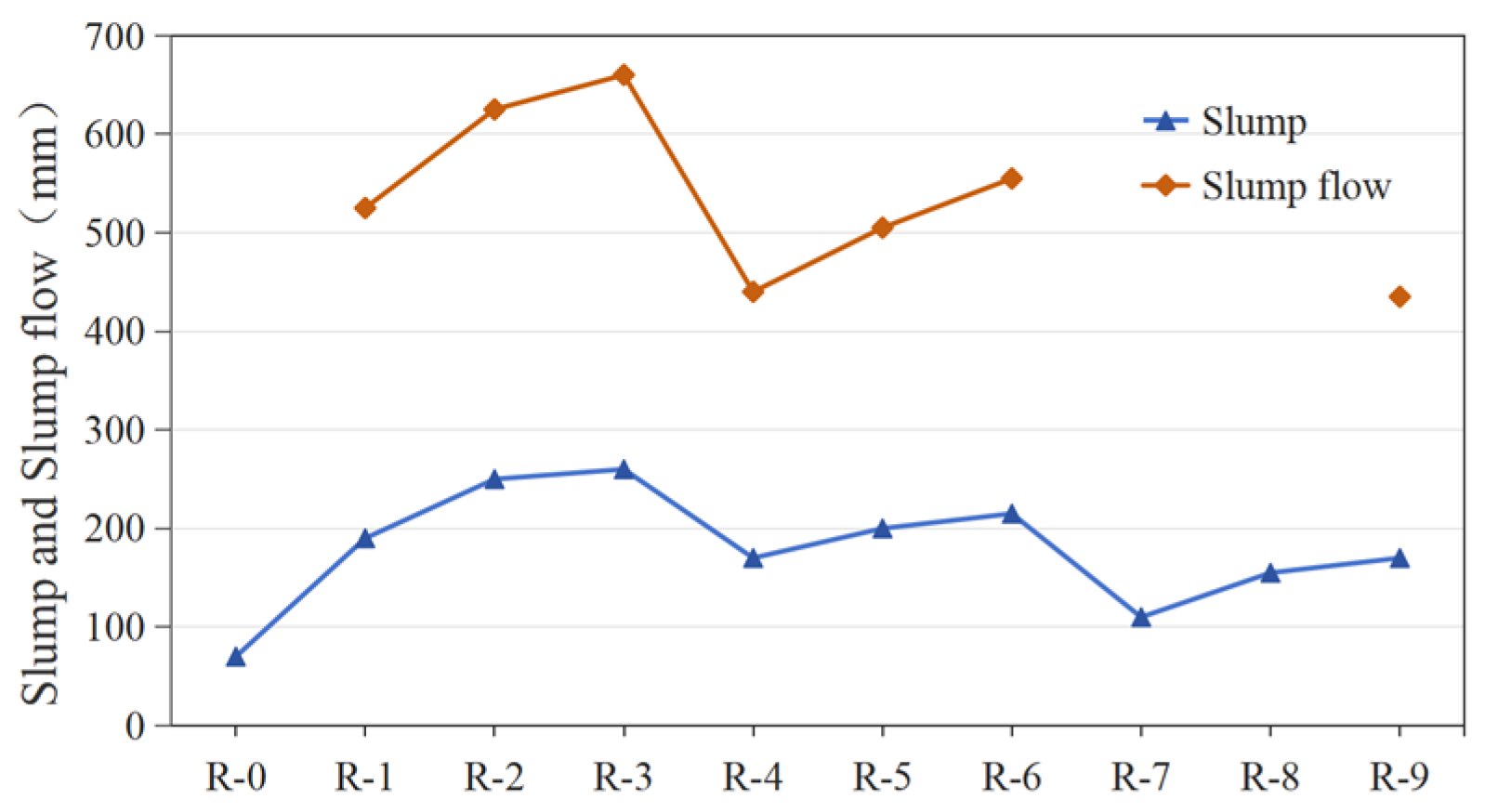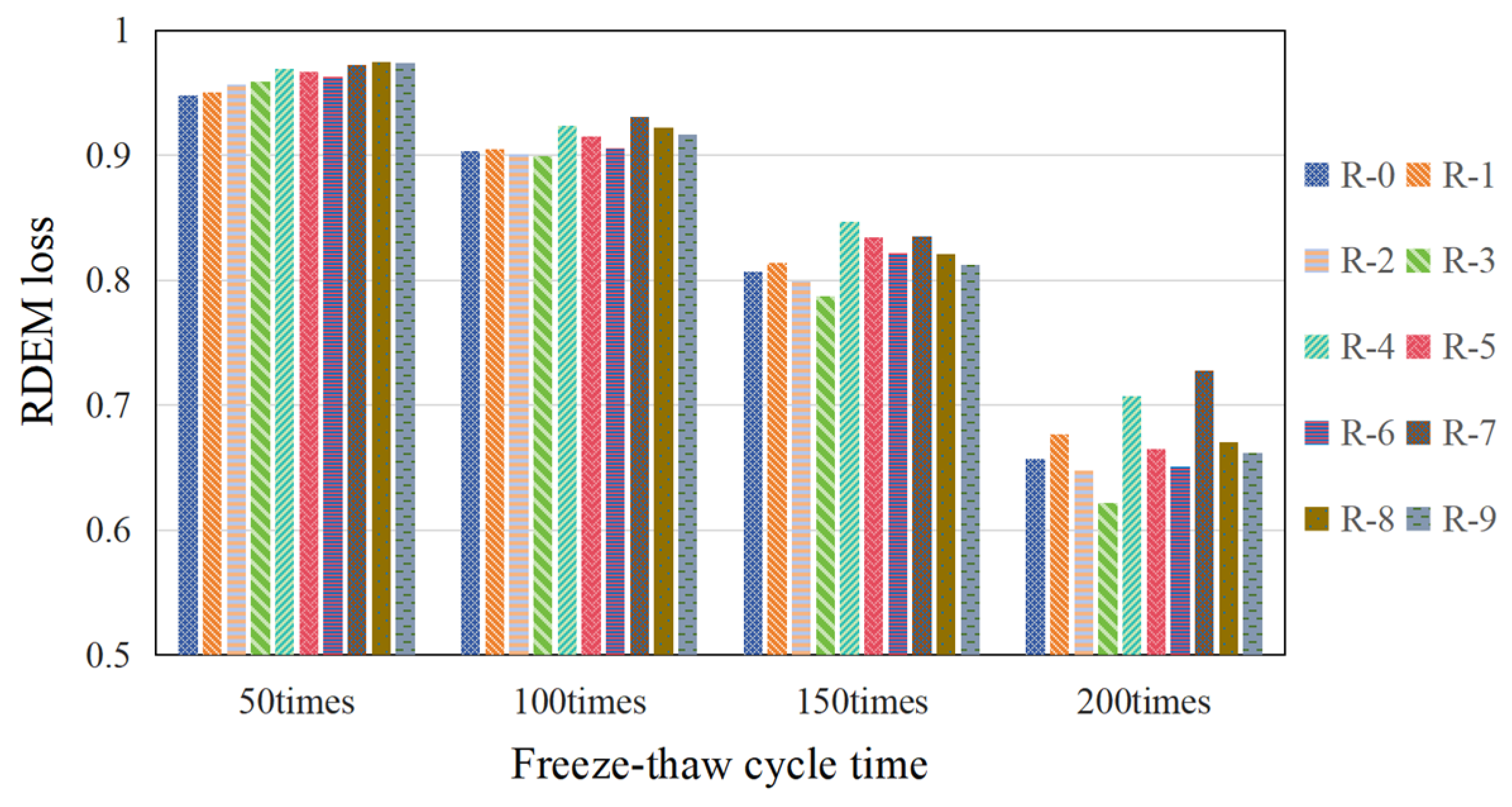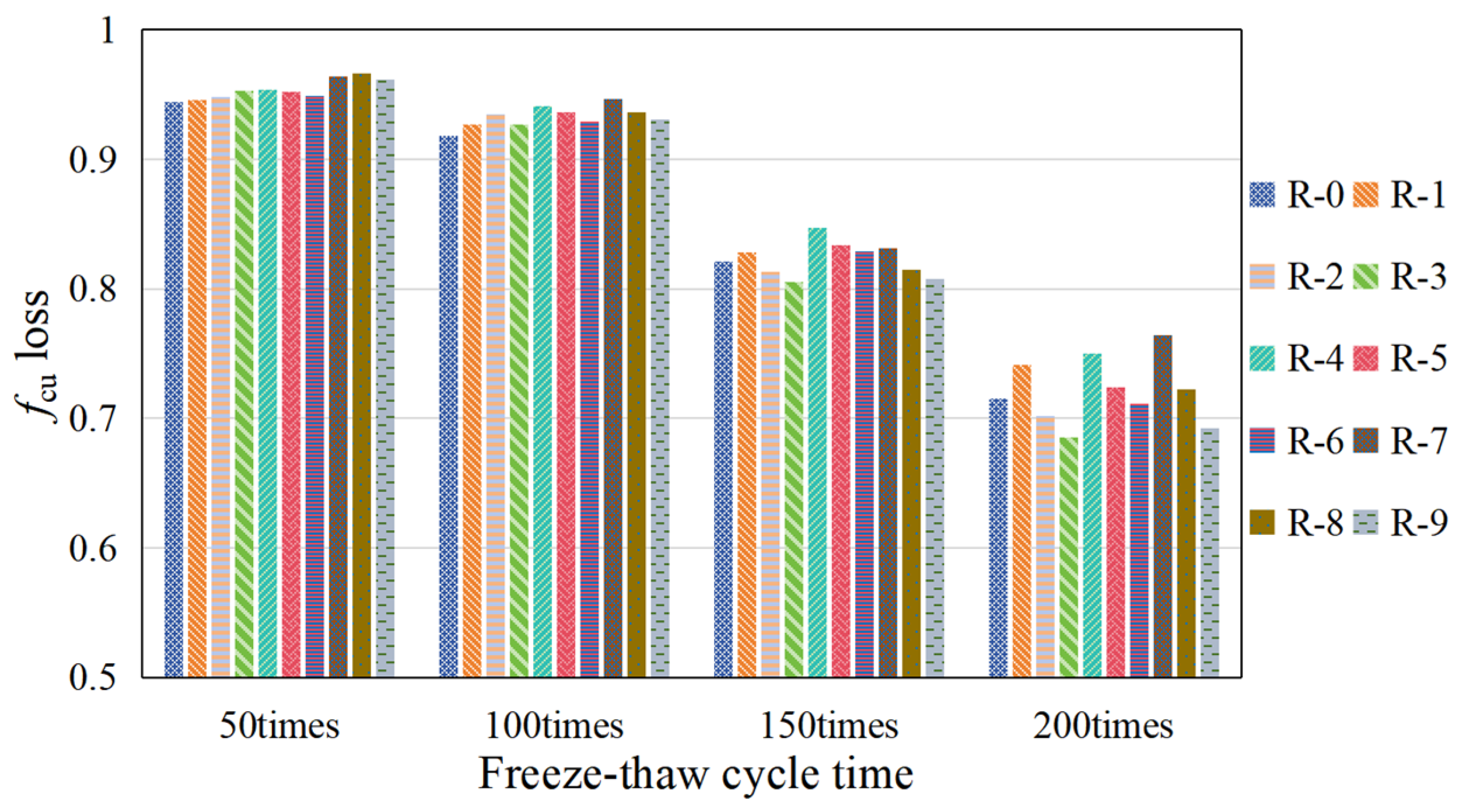Synergistic Freeze-Resistant Strategy of Multi-Stage PCM Concrete Incorporated with Rice Husk Ash and Fly Ash
Abstract
:1. Introduction
2. Materials and Experimental Details
2.1. Materials
2.2. Preparation of Specimens
- (1)
- Cement, sand, gravel, RHA and FA were first combined in a concrete mixer for 60 s.
- (2)
- Superplasticizer and water were then introduced, and mixing continued for another 120 s.
- (3)
- To avoid damaging the PCM aggregate, it was added in the third step and mixed for an additional 120 s.
- (4)
- The mixed material was finally poured into molds and compacted using vibration.
- (5)
- After a day, the specimens were demolded, and to guarantee adequate hardening, they were cured for 28 days at 20 °C in a controlled atmosphere with 96% humidity. The specimens, measuring 100 mm × 100 mm × 100 mm, were suitable for subsequent testing of mechanical, thermal and pore properties.
2.3. Testing Methods
2.3.1. Mechanical Properties
2.3.2. Thermal Properties
2.3.3. Time–Temperature Curve
2.3.4. Freeze Resistance
2.3.5. NMR
3. Results and Discussion
3.1. Mechanical Properties
3.2. Workability of Concrete
3.3. Thermal Properties
3.4. Time–Temperature Curve
3.5. Freeze Resistance
3.5.1. Mass Loss
3.5.2. RDEM Loss
3.5.3. Strength Loss
3.6. Evaluation of NMR
4. Conclusions
- (1)
- Balancing Mechanical and Thermal Performance: This study finds that an appropriate proportion of RHA and FA as cement replacements can effectively enhance the compressive strength of concrete while reducing thermal diffusivity and thermal conductivity. The results show that the compressive strength of concrete is the highest when the content of RHA and FA is 10%. This suggests that by precisely adjusting the replacement amounts of RHA and FA, significant improvements in the thermal properties of concrete can be achieved without sacrificing mechanical performance.
- (2)
- Thermal Regulation Capability: Incorporating RHA and FA enhances multi-stage PCM concrete’s capacity to regulate temperature. When the RHA content is 15% and the FA content is 30%, the highest temperature regulation capability can reach up to 5 °C. This capability is particularly important during environmental temperature fluctuations, helping to reduce concrete damage caused by temperature changes.
- (3)
- Pore Structure Optimization: The pore structure of the concrete was analyzed in detail using nuclear magnetic resonance technology. The results showed that the addition of RHA and FA altered the porosity of the concrete, with the best mechanical properties observed when the RHA and FA content was 10%.
- (4)
- Freeze Resistance: By simulating freeze–thaw environments, this study investigated the impact of different RHA and FA contents on the freeze resistance of concrete. The results show that when the RHA content is 15% and the FA content is 10%, the concrete exhibits the least mass loss and strength loss, demonstrating the best freeze resistance.
- (5)
- Environmental and Economic Benefits: The utilization of RHA and FA not only improves the durability of concrete but also reduces production costs and decreases the amount of cement used, offering significant environmental benefits.
Author Contributions
Funding
Data Availability Statement
Acknowledgments
Conflicts of Interest
References
- Zhao, H.B.; Hu, Y.; Tang, Z.; Wang, K.J.; Li, Y.A.; Li, W.G. Deterioration of concrete under coupled aggressive actions associated with load, temperature and chemical attacks: A comprehensive review. Constr. Build. Mater. 2022, 322, 126466. [Google Scholar] [CrossRef]
- Tang, M.; Tian, Y.; Zhang, D.; Kang, Y. Modification effect of concrete mixed hydrophobic and air-entraining admixture in traffic engineering in cold area. Concrete 2011, 4, 69–72. [Google Scholar]
- Xiao, Q.; Niu, D. Study on air-entraining fly-ash concrete in freeze-thaw environment. Concrete 2012, 273, 81–82. [Google Scholar]
- Zheng, A.; Zhao, G.; Li, Y.; Kang, X. Research on the durability of sleeper concrete containing mineral admixtures. Concrete 2011, 11, 95–97, 125. [Google Scholar]
- Li, Y.; Lu, H.; Yin, H.; Zhang, L.; Li, B.; Liu, R. Test research on the freezing-thawing resistance performance of high-strength concrete with single admixture and double admixtures. Ind. Constr. 2015, 45, 101977. [Google Scholar]
- Zhao, Y.; Cui, N.; Zhao, S.Y.; Zhu, Y.Z.; Hou, P.K.; Feng, L.C.; Xie, N. Aggressive Environment Resistance of Concrete Products Modified with Nano Alumina and Nano Silica. Front. Mater. 2021, 8, 695624. [Google Scholar] [CrossRef]
- Laustsen, S.; Hasholt, M.T.; Jensen, O.M. Void structure of concrete with superabsorbent polymers and its relation to frost resistance of concrete. Mater. Struct. 2015, 48, 357–368. [Google Scholar]
- Jensen, O.M. Use of Superabsorbent Polymers in Construction Materials, Microstructure Related Durability of Cementitious Composites; Rilem publications: Bagneux, France, 2008; Volume 1 and 2, pp. 757–764. [Google Scholar]
- Rustamov, S.; Kim, S.W.; Kwon, M.; Kim, J. Mechanical behavior of fiber-reinforced lightweight concrete subjected to repeated freezing and thawing. Constr. Build. Mater. 2021, 273, 121710. [Google Scholar] [CrossRef]
- Algin, Z.; Gerginci, S. Freeze-thaw resistance and water permeability properties of roller compacted concrete produced with macro synthetic fibre. Constr. Build. Mater. 2020, 234, 117382. [Google Scholar] [CrossRef]
- Si, R.Z.; Guo, S.C.; Dai, Q.L. Durability performance of rubberized mortar and concrete with NaOH-Solution treated rubber particles. Constr. Build. Mater. 2017, 153, 496–505. [Google Scholar] [CrossRef]
- Rodríguez, C.R.; de Mendonça, F.F.; Figueiredo, S.C.; Schlangen, E.; Savija, B. Fundamental investigation on the frost resistance of mortar with microencapsulated phase change materials. Cem. Concr. Compos. 2020, 113, 103705. [Google Scholar] [CrossRef]
- Hawes, D.W.; Feldman, D. Absorption of phase change materials in concrete. Sol. Energy Mater. Sol. Cells 1992, 27, 91–101. [Google Scholar] [CrossRef]
- Azakli, B.Z. Mitigating Freeze-Thaw Damage in Soils via Phase Change Materials (PCM). 2024. Available online: https://ersp.fzu.edu.cn/s/cn/clarivate/webofscience/G.https/wos/alldb/full-record/PQDT:88776447 (accessed on 16 July 2024).
- Adesina, P.A.; Olutoge, F.A. Structural properties of sustainable concrete developed using rice husk ash and hydrated lime. J. Build. Eng. 2019, 25, 100804. [Google Scholar] [CrossRef]
- Khan, M.; Ali, M. Improvement in concrete behavior with fly ash, silica-fume and coconut fibres. Constr. Build. Mater. 2019, 203, 174–187. [Google Scholar] [CrossRef]
- Supit, S.W.M.; Shaikh, F.U.A. Durability properties of high volume fly ash concrete containing nano-silica. Mater. Struct. 2015, 48, 2431–2445. [Google Scholar] [CrossRef]
- Meddah, M.S.; Praveenkumar, T.R.; Vijayalakshmi, M.M.; Manigandan, S.; Arunachalam, R. Mechanical and microstructural characterization of rice husk ash and Al2O3 nanoparticles modified cement concrete. Constr. Build. Mater. 2020, 255, 119358. [Google Scholar] [CrossRef]
- Prasittisopin, L.; Trejo, D. Effects of Mixing Time and Revolution Count on Characteristics of Blended Cement Containing Rice Husk Ash. J. Mater. Civ. Eng. 2018, 30, 04017262. [Google Scholar] [CrossRef]
- Shen, Y.L.; Liu, S.L.; Zeng, C.; Zhang, Y.J.; Li, Y.C.; Han, X.J.; Yang, L.; Yang, X.E. Experimental thermal study of a new PCM-concrete thermal storage block (PCM-CTSB). Build. Mater. 2021, 293, 123540. [Google Scholar] [CrossRef]
- Zhang, D.; Li, Z.; Zhou, J.; Wu, K. Development of thermal energy storage concrete. Cem. Concr. Res. 2004, 34, 927–934. [Google Scholar] [CrossRef]
- Ying, H.H.; Wang, S.L.; Lu, Z.; Liu, B.; Cui, L.; Quan, X.Y.; Liu, K.N.; Zhao, N. Development and thermal response of concrete incorporated with multi-stage phase change materials-aggregates for application in seasonally frozen regions. J. Build. Eng. 2023, 71, 106562. [Google Scholar] [CrossRef]
- Memon, S.A.; Cui, H.Z.; Lo, T.Y.; Li, Q.S. Development of structural-functional integrated concrete with macro-encapsulated PCM for thermal energy storage. Appl. Energy 2015, 150, 245–257. [Google Scholar] [CrossRef]
- Haider, M.Z.; Jin, X.H.; Sharma, R.; Pei, J.J.; Hu, J.W. Enhancing the compressive strength of thermal energy storage concrete containing a low-temperature phase change material using silica fume and multiwalled carbon nanotubes. Constr. Build. Mater. 2022, 314, 125659. [Google Scholar] [CrossRef]
- Essid, N.; Loulizi, A.; Neji, J. Compressive strength and hygric properties of concretes incorporating microencapsulated phase change material. Constr. Build. Mater. 2019, 222, 254–262. [Google Scholar] [CrossRef]
- Mohseni, E.; Tang, W.C.; Khayat, K.H.; Cui, H.Z. Thermal performance and corrosion resistance of structural-functional concrete made with inorganic PCM. Constr. Build. Mater. 2020, 249, 118768. [Google Scholar] [CrossRef]
- Gustafsson, S.E. Transient plane source techniques for thermal-conductivity and thermal-diffusivity measurements of solid materials. Rev. Sci. Instrum. 1991, 62, 797–804. [Google Scholar] [CrossRef]
- Fabiani, C.; Pisello, A.L. Coupling the transient plane source method with a dynamically controlled environment to study PCM-doped building materials. Energy Build. 2018, 180, 122–134. [Google Scholar] [CrossRef]
- GB/T 50082-2009; Standard for Test Methods of Long-Term Performance and Durability of Ordinary Concrete. Chinese Standard: Beijing, China, 2009.
- Liu, L.; He, Z.; Cai, X.H.; Fu, S.J. Application of Low-Field NMR to the Pore Structure of Concrete. Appl. Magn. Reson. 2021, 52, 15–31. [Google Scholar] [CrossRef]
- Chindaprasirt, P.; Rukzon, S. Strength, porosity and corrosion resistance of ternary blend Portland cement, rice husk ash and fly ash mortar. Constr. Build. Mater. 2008, 22, 1601–1606. [Google Scholar] [CrossRef]
- Amin, M.; Abdelsalam, B.A. Efficiency of rice husk ash and fly ash as reactivity materials in sustainable concrete. Sustain. Environ. Res. 2019, 29, 30. [Google Scholar] [CrossRef]
- Farahani, J.N.; Shafigh, P.; Alsubari, B.; Shahnazar, S.; Mahmud, H.B. Engineering properties of lightweight aggregate concrete containing binary and ternary blended cement. J. Clean. Prod. 2017, 149, 976–988. [Google Scholar] [CrossRef]
- Kwan, A.K.H.; Li, Y. Effects of fly ash microsphere on rheology, adhesiveness and strength of mortar. Constr. Build. Mater. 2013, 42, 137–145. [Google Scholar] [CrossRef]
- Mydin, M.A.O.; Sor, N.H.; Althoey, F.; Özkılıç, Y.O.; Abdullah, M.M.A.B.; Isleem, H.F.; Deifalla, A.F.; Tawfik, T.A. Performance of lightweight foamed concrete partially replacing cement with industrial and agricultural wastes: Microstructure characteristics, thermal conductivity, and hardened properties. Ain Shams Eng. J. 2023, 14, 102546. [Google Scholar] [CrossRef]
- Ma, W.; Lv, B.; Wang, Y.; Huang, L.; Yan, L.; Kasal, B. Freeze-thaw, chloride penetration and carbonation resistance of natural and recycled aggregate concrete containing rice husk ash as replacement of cement. J. Build. Eng. 2024, 86, 108889. [Google Scholar] [CrossRef]
- Li, Y.L.; Ma, H.; Wen, L.F.; Yuan, J.P.; Zhang, Y.; Li, Y.; Zhou, H.; Chen, J.H. Influence of pore size distribution on concrete cracking with different AEA content and curing age using acoustic emission and low-field NMR. J. Build. Eng. 2022, 58, 105059. [Google Scholar] [CrossRef]
- Zhou, S.D.; Liu, D.M.; Cai, Y.D.; Yao, Y.B. Fractal characterization of pore-fracture in low-rank coals using a low-field NMR relaxation method. Fuel 2016, 181, 218–226. [Google Scholar] [CrossRef]
- Sua-iam, G.; Makul, N. Utilization of high volumes of unprocessed lignite-coal fly ash and rice husk ash in self-consolidating concrete. J. Clean. Prod. 2014, 78, 184–194. [Google Scholar] [CrossRef]
- Medina, C.; del Bosque, I.F.S.; Frías, M.; de Rojas, M.I.S. Design and characterisation of ternary cements containing rice husk ash and fly ash. Constr. Build. Mater. 2018, 187, 65–76. [Google Scholar] [CrossRef]
- Kumar, R.; Bhattacharjee, B. Porosity, pore size distribution and in situ strength of concrete. Cem. Concr. Res. 2003, 33, 155–164. [Google Scholar] [CrossRef]
- Zhang, S.Y.; Zheng, S.Q.; Wang, E.; Dai, H.J. Grey model study on strength and pore structure of self-compacting concrete with different aggregates based on NMR. J. Build. Eng. 2023, 64, 105560. [Google Scholar] [CrossRef]














| Density (g·cm−3) | Specific Surface Area (m2·g−1) | Loss on Ignition (%) | Initial Setting Time (min) | Final Setting Time (min) |
|---|---|---|---|---|
| 3.12 | 0.35 | 3.02 | 135 | 250 |
| SiO2 | CaO | Al2O3 | Fe2O3 | MgO | SO3 | Na2O | K2O | TiO2 | MnO | P2O5 | |
|---|---|---|---|---|---|---|---|---|---|---|---|
| Cement | 18.68 | 64.27 | 4.01 | 3.97 | 2.87 | 3.26 | 0.12 | 0.43 | 0.57 | 0.10 | 1.05 |
| RHA | 86.82 | 1.70 | 0.47 | 1.71 | 0.61 | 0.55 | 0.20 | 5.12 | 0.05 | 0.45 | 1.89 |
| FA | 43.46 | 10.05 | 30.57 | 9.12 | 2.08 | 0.53 | 1.02 | 0.67 | 0.55 | 0.05 | 1.30 |
| Mix | RHA Content | FA Content | Cement | RHA | FA | Sand | PCM Aggregate | Water | SP |
|---|---|---|---|---|---|---|---|---|---|
| R-0 | 0% | 0% | 550 | 0 | 0 | 652 | 560 | 176 | 5.5 |
| R-1 | 5% | 10% | 467.5 | 27.5 | 55 | 652 | 560 | 176 | 5.5 |
| R-2 | 5% | 20% | 412.5 | 27.5 | 110 | 652 | 560 | 176 | 5.5 |
| R-3 | 5% | 30% | 357.5 | 27.5 | 165 | 652 | 560 | 176 | 5.5 |
| R-4 | 10% | 10% | 440 | 55 | 55 | 652 | 560 | 176 | 5.5 |
| R-5 | 10% | 20% | 385 | 55 | 110 | 652 | 560 | 176 | 5.5 |
| R-6 | 10% | 30% | 330 | 55 | 165 | 652 | 560 | 176 | 5.5 |
| R-7 | 15% | 10% | 412.5 | 82.5 | 55 | 652 | 560 | 176 | 5.5 |
| R-8 | 15% | 20% | 357.5 | 82.5 | 110 | 652 | 560 | 176 | 5.5 |
| R-9 | 15% | 30% | 302.5 | 82.5 | 165 | 652 | 560 | 176 | 5.5 |
Disclaimer/Publisher’s Note: The statements, opinions and data contained in all publications are solely those of the individual author(s) and contributor(s) and not of MDPI and/or the editor(s). MDPI and/or the editor(s) disclaim responsibility for any injury to people or property resulting from any ideas, methods, instructions or products referred to in the content. |
© 2024 by the authors. Licensee MDPI, Basel, Switzerland. This article is an open access article distributed under the terms and conditions of the Creative Commons Attribution (CC BY) license (https://creativecommons.org/licenses/by/4.0/).
Share and Cite
Hong, Z.; Wang, S.; Ying, H.; Lu, Z.; Liu, B.; Xu, J. Synergistic Freeze-Resistant Strategy of Multi-Stage PCM Concrete Incorporated with Rice Husk Ash and Fly Ash. Buildings 2024, 14, 2604. https://doi.org/10.3390/buildings14092604
Hong Z, Wang S, Ying H, Lu Z, Liu B, Xu J. Synergistic Freeze-Resistant Strategy of Multi-Stage PCM Concrete Incorporated with Rice Husk Ash and Fly Ash. Buildings. 2024; 14(9):2604. https://doi.org/10.3390/buildings14092604
Chicago/Turabian StyleHong, Zhilong, Sheliang Wang, Honghao Ying, Zhe Lu, Bo Liu, and Jin Xu. 2024. "Synergistic Freeze-Resistant Strategy of Multi-Stage PCM Concrete Incorporated with Rice Husk Ash and Fly Ash" Buildings 14, no. 9: 2604. https://doi.org/10.3390/buildings14092604





